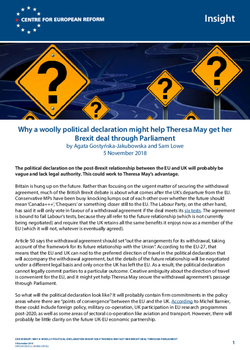
Why a woolly political declaration might help Theresa May get her Brexit deal through Parliament
The political declaration on the post-Brexit relationship between the EU and UK will probably be vague and lack legal authority. This could work to Theresa May's advantage.
Britain is hung up on the future. Rather than focusing on the urgent matter of securing the withdrawal agreement, much of the British Brexit debate is about what comes after the UK’s departure from the EU. Conservative MPs have been busy knocking lumps out of each other over whether the future should mean ‘Canada+++’, ‘Chequers’ or something closer still to the EU. The Labour Party, on the other hand, has said it will only vote in favour of a withdrawal agreement if the deal meets its six tests. The agreement is bound to fail Labour’s tests, because they all refer to the future relationship (which is not currently being negotiated) and require that the UK retains all the same benefits it enjoys now as a member of the EU (which it will not, whatever is eventually agreed).
Article 50 says the withdrawal agreement should set “out the arrangements for its withdrawal, taking account of the framework for its future relationship with the Union”. According to the EU-27, that means that the EU and UK can nod to the preferred direction of travel in the political declaration that will accompany the withdrawal agreement, but the details of the future relationship will be negotiated under a different legal basis and only once the UK has left the EU. As a result, the political declaration cannot legally commit parties to a particular outcome. Creative ambiguity about the direction of travel is convenient for the EU, and it might yet help Theresa May secure the withdrawal agreement’s passage through Parliament.
The political declaration will probably all be couched in warm words and platitudes, designed to make it palatable to the British parliament.
So what will the political declaration look like? It will probably contain firm commitments in the policy areas where there are “points of convergence” between the EU and the UK. According to Michel Barnier, these could include foreign policy, military co-operation, UK participation in EU research programmes post-2020, as well as some areas of sectoral co-operation like aviation and transport. However, there will probably be little clarity on the future UK-EU economic partnership.
The parties might express their willingness to pursue a close economic partnership that obviates the need for the Irish backstop, perhaps with specific mention of their shared ambition for tariff- and quota-free trade in goods and agriculture, but in reality the declaration will leave a range of potential trade relationships on the table. The political declaration might also include additional reassurances on Northern Ireland, such as an intention to negotiate a supplementary whole-UK customs union with the EU, to further ‘de-dramatise’ the backstop. (It is reported that negotiations are ongoing on whether a reference to a whole-UK customs union should be included in the withdrawal agreement.)
The political declaration will probably all be couched in warm words and platitudes, designed to make it palatable to the British parliament. Some officials have compared the declaration to a Twix bar: the solid commitments are the biscuit base, the economic partnership is the fudge, and everything is wrapped up in an enticing layer of chocolatey sweetness.
The declaration might also address the question of whether the EU and the UK should aim to negotiate one comprehensive agreement on the future relationship, covering the whole spectrum of policy areas, or reach a series of deals in parallel. The European Parliament, which has to approve the final text of the withdrawal agreement, will also want to see a clear intention from member-states and the Commission that the current level of MEPs’ influence over the Brexit talks will continue.
On the EU side, it is easier for the 27 to maintain their unity if they keep the declaration vague – the more details they include, the longer a discussion they would need in order to weigh their priorities. Besides, current EU leaders are running out of time: EU voters will elect the new European Parliament in May 2019, and European Commission President Jean-Claude Juncker will pass the baton to his successor in the autumn of 2019. It is likely that populists will win more seats in the European Parliament and make the EU decision-making process more troublesome. Member-states would not want to make a legally binding commitment that they might find hard to deliver if the political winds in Brussels change in 2019. Kicking the decision on the future relationship into the post-Article 50 discussions would also give the EU more room for manoeuvre if Britain changed its mind and sought closer ties with the Union.
A political declaration, carrying little legal certainty, will be – no doubt – a hard sell to MPs, who will have to approve Theresa May’s Brexit deal. They will argue that the EU itself is not consistent about sequencing in the Brexit talks: the EU-27 inserted the Northern Ireland backstop into the withdrawal agreement, even though that is an issue of the future relationship, so if the UK pushed really hard for a detailed or legally binding declaration the EU might change its mind. The Commons committee on exiting the European Union said in June 2018 that it would expect a high level of detail in the political declaration if it was to approve the withdrawal deal. It also called on the government to seek to insert the declaration as an annex to the withdrawal agreement, so that it had greater prominence. Some Brexit hardliners have also convinced themselves, contrary to the available evidence, that the £40 billion ‘Brexit bill’ is a down-payment on a favourable future relationship, not payment of money owed. They will want a binding declaration saying that the EU will give the UK a sweet deal, as a guarantee that the UK will get good value for the tax payers’ money.
A political declaration, carrying little legal certainty, will be – no doubt – a hard sell to MPs, who will have to approve Theresa May’s Brexit deal.
MPs might also think that unless there is another general election in the UK, the vote on the withdrawal agreement and the political declaration could be the last chance for Parliament to shape the final Brexit outcome, because international treaties are negotiated by the government, and existing parliamentary scrutiny procedures do not allow MPs to have thorough oversight of the talks.
To address these expected anxieties, the UK government is reported to be seeking ways to make the political declaration appear more binding than it is. It is, however, still unclear how this would be done, although consideration has been given to options such as depositing the declaration at the UN like a proper international treaty, as was intended for David Cameron’s ill-fated reform deal with the EU in February 2016. Such quasi-legal theatre might help with the political optics, but ultimately British parliamentarians should not expect a political declaration that binds the EU legally to a specific outcome.
A woolly declaration on the future might not feel fair to many MPs. But the idea that the UK could negotiate its departure from the EU and the comprehensive future relationship in two years was always for the birds. And once the initial wave of outrage recedes, the declaration’s ambiguity may yet work to May’s advantage.
Those favouring a softer Brexit might opt to vote in favour of the deal, gambling that, post-Brexit, MPs currently campaigning for a referendum on the final deal will come on-side. They will then have the parliamentary numbers to ensure that the UK ends up in a close relationship with the EU. This approach may also appeal to some Labour MPs who might be tempted to vote with the government so as to respect the referendum result, but will be able to argue that they retain the ability to shape the future relationship.
Hard Brexiteers will be initially furious; they want a clear indication in the declaration that the UK and the EU will pursue the ‘Canada model’ of an FTA. But equally, they want the UK to leave the EU so badly that they might embrace a woolly declaration to ensure that the UK leaves on schedule. They would then hope to be able to replace May with one of their own, and build a parliamentary majority for a bigger rupture once the UK has left and the threat of remaining in the EU has vanished. Indeed, the Secretary of State for Environment, Food and Rural Affairs, Michael Gove, has alluded to such an approach.
In any circumstances, it is difficult to foresee a scenario where the DUP are not an issue for May, and a vague declaration at least leaves open the possibility of capturing a majority in the House of Commons.
Of course, this still leaves the issue of the Democratic Unionist Party (DUP). But there is no reason to think that a detailed, binding declaration (which is in any case impossible) would make May’s life any easier in this regard. If May were to negotiate a binding political declaration that locked in a close UK-EU relationship that might guarantee her DUP support, but it would risk losing the right of her party; while a political declaration that locked in a looser relationship with the EU would necessitate a distinct relationship for Northern Ireland from day one, costing her DUP votes. In any circumstances, it is difficult to foresee a scenario where the DUP cease to be an issue for May, and a vague declaration at least leaves open the possibility of capturing a majority in the House of Commons.
The fact that British politics has still not recognised that the future relationship will be negotiated only after the withdrawal agreement is agreed is indicative of a public debate that has struggled with the detail; failed to grasp the parameters of what is being negotiated and when; and has wilfully ignored the power imbalance in favour of the EU inherent in the Article 50 process. But once MPs realise that the eventual landing zone is bound to remain uncertain even after the withdrawal agreement is finalised, and the inevitable outcry subsides, an ambiguous political declaration could yet prove to be the best of bad options for May, and for Brexiteers of all stripes.
Agata Gostyńska-Jakubowska and Sam Lowe are senior research fellows at the Centre for European Reform.


Add new comment